Exhibit Overview
North America exhibits from the hot and dry Sonoran Desert to the icy Rocky Coast. Plan on two to three hours to tour the North America region.
Rocky Coast
Chill out at the Rocky Coast exhibit and take in the cool wonders of the arctic. This popular exhibit features seabird, peregrine falcon and harbor seal. Underwater viewing allows patrons to get close to these amazing animals.
Arctic Fox
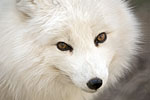
These small foxes have snow white fur in the winter and shed out to a short, brown fur in the summer. Change of color provides very effective camouflage. Incredibly hardy, this fox can handle extremely cold temperatures.
Harbor Seal
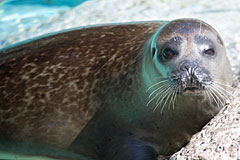
Feeding times are posted daily at the exhibit. Zookeepers normally post one to two feeding times.
Limbs are modified into flippers. Foreflippers have all the same skeletal features of land mammal forelimbs. These flippers are used to help steer underwater. They have noticeable, but short, blunt claws which are used for scratching, grooming, and defense. Hind flippers are webbed, and when spread, the hind flippers resemble a fan. Hind flippers are moved side-to-side to provide propulsion. All flippers are covered with hair.
Peregrine Falcon
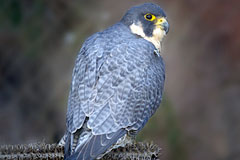
This falcon is one of the types of birds know as raptors or birds of prey. The name comes from raptus, meaning “to seize” and all raptors have hooked beaks and sharp talons. It was one of the most widespread birds in the world. The Peregrin falcon is the fastest living animal in the world, able to reach speeds of 200 MPH in a dive. Having been recently removed from the endagered list, its populations are still monitored.
Polar Bear
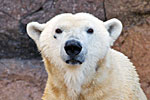
These iconic bears of the Arctic are the top predators of the north. They can weigh 1200 pounds and when standing, they might reach 11 feet tall. Their favorite food is ringed seals, and sometimes they only eat the energy rich fat, leaving the rest for others in the far north. They hunt and rest from the sea ice, so they need it to stay cold in the Arctic.
Sea Lion
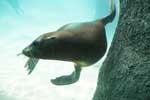
Feeding times are posted daily at the exhibit. Zookeepers normally post one to two feeding times.
The playful California sea lion is a very agile swimmer. They are distinguished from seals by having hind flippers that can rotate forward (allowing them to “walk” on land) and the presence of external ear flaps. This social marine mammal can dive 500 feet in search of squid, herring, mackerel and more. Our sea lions were stranded as pups and nursed back to health by caring people.
Sea Birds
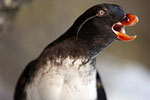
The seabirds are fed at 2:30 p.m. daily.
Marsh
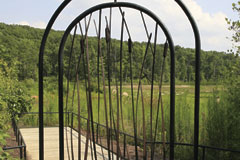
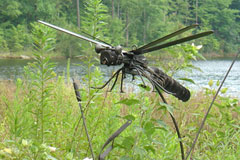
Depending on when you visit, you might see dozens of birds, hundreds of insects dancing around flowers like the dragonfly depicted in the scrap metal sculpture "Lisa's Dragonfly" above, beavers, muskrats, water snakes, or frogs. The Cattail-adorned Gate leads you into the Marsh observation area.
Cypress Swamp
Cypress swamps are in the humid southeastern United States. At the NC Zoo cougars, ducks, alligators, turtles, frogs, and snakes share this exhibit.
Alligator Snapping Turtle
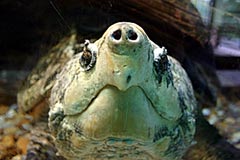
(No description available)
American Alligator
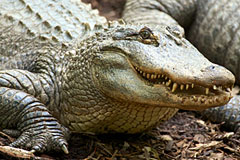
Did you know alligators do not eat during the winter? Between May 1 and Sept. 30, our alligators are fed Saturdays and Sundays only. Feeding times are posted at the exhibit.
American alligators reach lengths up to 15 feet and may weigh over 700 pounds. These meat-eaters lose teeth throughout their lives, and may have 2000-3000 in their lifetime. Their wallows (or “gator holes”) create small aquatic microhabitats for many other animals of the swamp.
Cougar
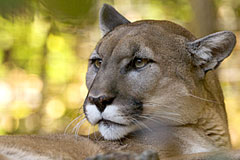
Are the largest of the small cats. All large cats can roar, while small cats cannot. Cubs are born with blue eyes and spotted coats (for camouflage) – spots disappear by age 2. Can spring 18’ into a tree and leap 40’ horizontally.
Louisiana Pine Snake
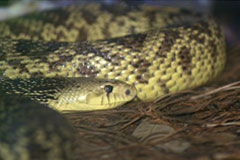
The rarest snake in North America and one of the rarest vertebrates in the U.S. There may be as few as 75 animals left in the wild. The snake relys almost exclusively on Baird’s pocket gopher as a food source and lives within their burrow systems. The habitat is dependent on fire to maintan the pine forest and fire suppression has reduced quality pine snake habitat remarkably. Controlled burning is now in place in areas of Louisiana to restore the open understory of longleaf pine ecosystems. The species has the largest eggs and hatchlings of all North American snakes.
Marbled Salamander
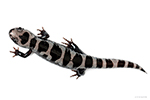
A chunky, small salamander with white to light gray crossbands across the head and back, down to the tail. They are solitary and spend most of their time under leaf litter or even underground. They do defend their burrows against others. This salamander is found in most of the eastern United States, from MA to the Gulf States and to MO and TX. Unique among salamanders, they breed in the fall and do not breed in the water. Breeding occurs on land, in dried up ponds, pools and ditches. The eggs are deposited under leaves in these small depressions. They will hatch the following year when the area fills again with water. The female stays with the eggs to protect them and keep them moist. Breeding only happens once per year.
Stream Side
At this exhibit you’ll discover a diversity of animals of along a Carolina stream. Streams are part of “nature’s waterworks,” an enormous circulating system that cleanses and distributes water across the land.
Barred Owl
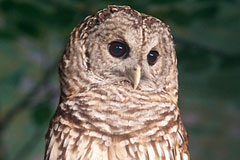
The vocal barred owl is well known for its distinctive call, which sounds like the bird calling “Who cooks for you … who cooks for you all?” They often swallow their prey whole and, after digesting the softer parts, the parts that cannot be digested form into a pellet that is then coughed up. Scientists collect and dissect these pellets and determine what animals are in a habitat based on what the owls are eating.
Bobcat
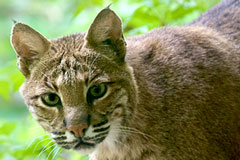
Named for their short tails which appears to be “bobbed”. Even though they are only about twice the size of a housecat, Bobcats are powerful. They stalk their prey in silence, then leap on it from a distance of up to 10 feet! They have excellent vision and hearing to go along with a good sense of smell. Bobcats use their whiskers like fingertips to “feel” prey even in the dark.
Copperhead
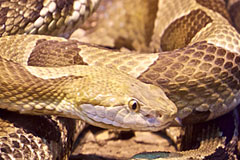
Copperheads are ovoviviparous – giving birth to live young after the young develop inside the body of the mother. The mother produces a large, yolk-filled egg that is kept in the reproductive tract during development. During this time, the embryo receives no nourishment from the mother (although inside her) – instead, receives it from the yolk sac. Young are born within a membranous sac that they emerge from immediately after being expelled from the mother. There is no direct care by the mother. Young are born with a bright yellow tail that they use as a lure for small prey items.
Eastern Cottonmouth
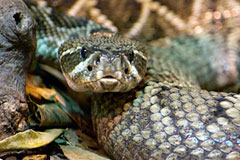
The venom of the cottonmouth is hemotoxic (like the copperhead) – breaking down and destroying blood cells and other tissues as well as reducing the bloods ability to clot – all resulting in massive hemorrhaging throughout the body of the victim. Reptiles and amphibians are often held onto for a few moments, giving the venom time to take effect; mammals are bitten and released (to reduce the chance of injury from an animal fighting back). Animals that do not die immediately are tracked down by scent.
Eastern Diamondback Rattlesnake
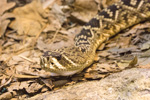
Largest venomous snake in North America. Very beneficial to man as they are effective natural pest controllers. Baby rattlesnakes can deliver a venomous bite that may be more severe than an adult’s bite. Young snakes cannot control the flow of venom as an adult can. Rattlesnake’s age is NOT evident by the number of segments on the rattle. Rattles will break off, and the animal’s shed more than once per year.
River Otter
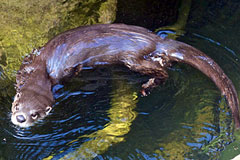
This aquatic mammal is streamlined with a powerful tail that helps push them through the water. Short, stiff whiskers pick up movement and obstacles underwater. The best habitat for them has a lot of plants, slow moving water and plenty of fish. They are sensitive to pollution and will leave polluted waterways if possible.
Spotted Turtle
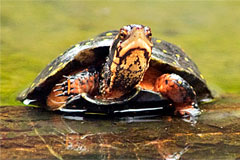
This species is named for yellow spots covering its shell and on its head, neck, and limbs. A small turtle with a broad, dark carapace, the shell has scattered yellow dots or spots. These yellow spots on the head, neck and limbs aid in identification. Males have brown eyes, a tan chin, and a long thick tail. Females have orange eyes, and a yellow chin. Active from March to October, they are often seen basking in the sun. They are highly aquatic and will bury themselves in response to a perceived threat. Omnivores, they eat snails, slugs, insects, small crayfish, worms, and spiders make up their diet. Also eat some vegetation including leaves, grasses, and seeds.
Two-toed Amphiuma
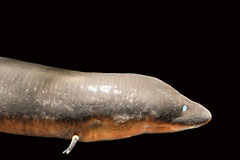
The two-toed amphiuma is the largest salamander in North America, reaching a length of four feet. All four limbs are present, but they are significantly reduced giving them an eel-like apperance.
Yellow Rat Snake
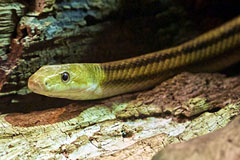
The snake is named for its healthy appetite for rodents. A non-venomous snake, this constrictor kills its prey by wrapping coils around it and squeezing with tremendous force, cutting off their air supply and even limiting blood flow. Truly arboreal snakes, they climb very well, and may reach heights of 60 ft in search of birds or bird eggs. The belly scales are more square, helping with climbing. When not in trees they are often found under boards, in leaf litter and under rocks and also spend a lot of time in rodent burrows, pursuing prey. When threatened they will freeze.
Bears
Content
Honey Bee Garden
At the Honey Bee Garden exhibit, you will see a living bee hive, get the inside scoop on bee colonies and see how plants, bees and people all work together to produce honey and so much more.
Prairie
The great prairies of the American Midwest were once home to gigantic herds of bison. At the NC Zoo, experience our short-grass prairie complete with a herd of bison and elk that can be viewed from four overlooks.
Bison
Once found in most of Canada, the US, and parts of Mexico. Wild populations are now limited to national parks (like Yellowstone) and refuges. Bison are very different from buffalo; bison are only found in North America, while buffalo are found in Asia and Africa.
Elk
Bull(male) elk lose their antlers each March, but they begin to grow them back in May in preparation for the late-summer breeding season. Antlers are covered in velvet until the fall rut when antlers are needed for competing for female. When in rut, males will also bugle to attract females.
Red Wolf
Content
The Desert
Content
© North Carolina Zoo